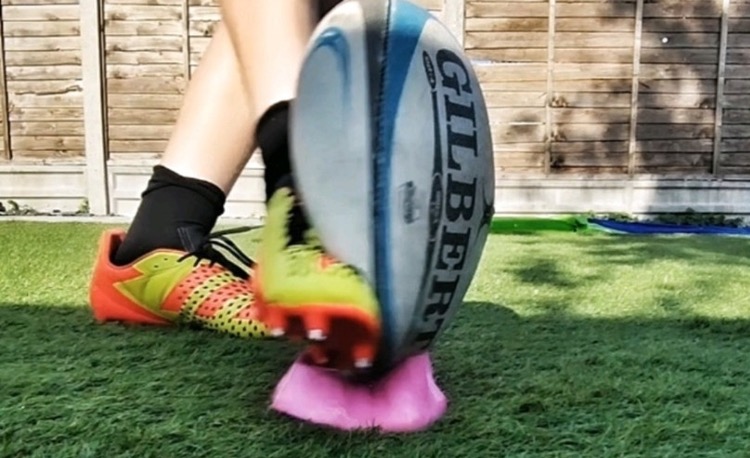Place kicking is all about the hips
There is no one style that defines a good place kicker. However, they are some fundamental areas you can influence to improve your kicker’s accuracy. By Doug McClymont, a leading rugby biomechanist.
Because of the shape of the thigh bone (the femur), the best way to kick is to lean to the side. This is due to the circular motion of the leg as it swings across the body.
This same anatomy is vital when considering the place kick. You can help the kicker decide on the best set up for the ball on the tee and the angle at which they approach the kick.
A great variation of kicking methods
Looking at the best kickers in the game, you can see a great variation in the position and angle of the planted foot, how much they lean to one side, their angle of approach, the point of contact with the foot, and the angle of the ball on the tee.
There are even a vast variety of tees.
Given these large number of variables, I am going to concentrate on two areas where you can have a significant influence: the angle of the ball on the tee and role of the hip above the planted foot. This will help kickers understand why they may want to use a certain approach given their own particular style.
Two ways to tee up the ball

Kickers traditionally kick with either their instep or by side-footing the ball. Most prefer the former, where the impact is around the laces on the boot.
In both cases, the ball is teed up so that the player strikes the ball on the “sweet spot” with his foot. This spot is about a third of the way up on the ball.
Tilt back for the instep kick
The best instep kick has the foot remaining on the same path as the leg. The ball is stuck with the top of the foot against the curved face of the ball. The ball should be slightly titled back, towards the kicker or sometimes upright.
Tilt forwards for the side foot kick

Though not totally a side foot kick, this place kick has the player rotating his foot slightly outwards. A sweeping motion, rather than the swing of the leg, brings the foot in contact with ball just behind the big toe joint (the first metatarsal).
The foot will connect with the ball about a third of the way up it. To ensure this happens, the ball should be slightly tilted forwards.
The run-up and hips

The angle of the run-up must be one which allows the kicker to accommodate the swing of the leg with the intended direction of the ball.
The exact angle and placement of the planted foot varies between kickers and you should let the kickers work this out for themselves.
There are also various opinions on where the planted foot should be and if the kicker should have their head over the knee at contact or be leaning back. However, what you can influence with more certainty is how the hip operates in the kick.

A key determinant for the accuracy of a place kick is the rotation of the pelvis about the planted foot and leg. I see few coaches working on this aspect. The hip rotates around the planted leg.
The speed of this rotation is a considerable component of the kicking foot speed. It also is a major factor in what direction the kicking foot takes, in other words, the circular path of the kicking leg.
If the motion of the leg continues on its normal circular path, the time during which the direction of the foot at contact is directly at the goalposts is extremely small.
But, if the planted hip is strongly extended or pushed forward, just prior to and during the contact, then the path of the kicking foot will be in line with the posts for longer, albeit still a short time. It is the same principle of a baseball batter stepping forward to hit the ball or a golfer who extends his front hip for stability.
Thanks to Finlay Woods for the close-ups of the ball placement, run ups and impact on the ball. You can follow his kicking journey here.
Related Files
Newsletter Sign Up
Coaches Testimonials

Gerald Kearney, Downtown Las Vegas Soccer Club

Paul Butler, Florida, USA

Rick Shields, Springboro, USA

Tony Green, Pierrefonds Titans, Quebec, Canada
Subscribe Today
Be a more effective, more successful rugby coach
In a recent survey 89% of subscribers said Rugby Coach Weekly makes them more confident, 91% said Rugby Coach Weekly makes them a more effective coach and 93% said Rugby Coach Weekly makes them more inspired.
Get Weekly Inspiration
All the latest techniques and approaches
Rugby Coach Weekly offers proven and easy to use rugby drills, coaching sessions, practice plans, small-sided games, warm-ups, training tips and advice.
We've been at the cutting edge of rugby coaching since we launched in 2005, creating resources for the grassroots youth coach, following best practice from around the world and insights from the professional game.









